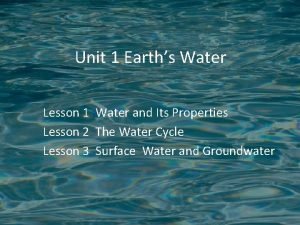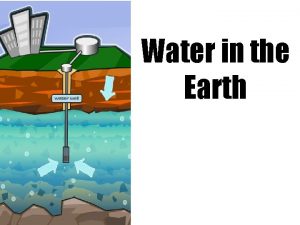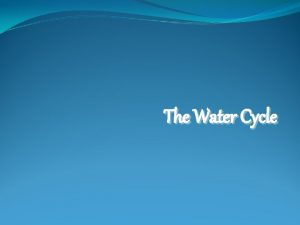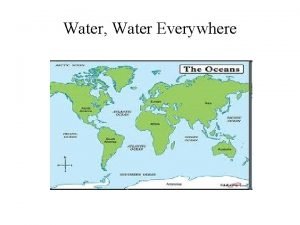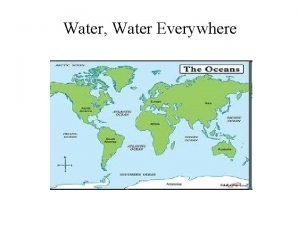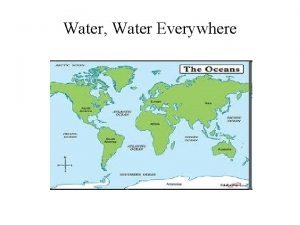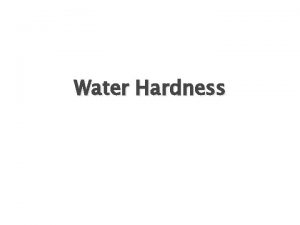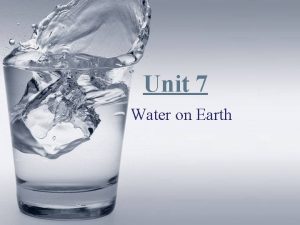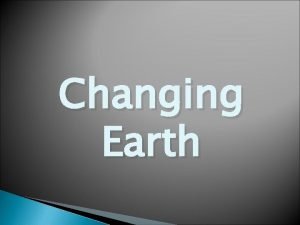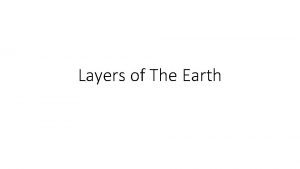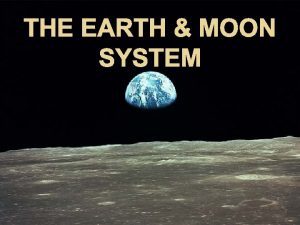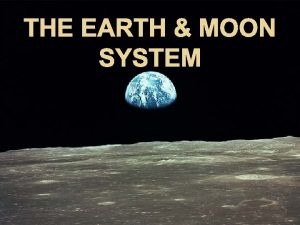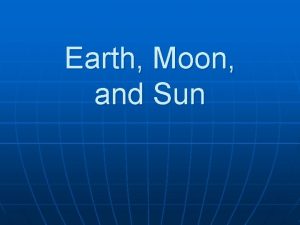Lesson 2 3 Water on Earth The Earth




























- Slides: 28

Lesson 2 & 3: Water on Earth

The Earth

Earth • 71% covered by oceans • Name the 4 oceans • Only 3% of the water is fresh • Majority is trapped in ice (glaciers & sea ice caps) • Dynamic with changing “spheres” • • Hydrosphere Biosphere Atmosphere Lithosphere

Earth • Contains both renewable and nonrenewable resources • Renewable resource – can replenish itself naturally over a relatively short period of time. • Nonrenewable resource – exhausted faster than they can be naturally replaced. • Are oceans a renewable or a nonrenewable resource?

Earth • Marine habitats are distributed based on water’s physical properties. • Water’s unique properties are due to the chemistry of its molecule.

Basic Chemistry

Review • Water’s unique properties are due to the chemistry of its molecule. • Atom – the basic particle of each unique element. • Neutron • Proton • Electron

Review • Bonding – the process that makes individual elements stable What determines how elements bond with other elements? • Covalent bonds – elements share their valence electrons • Diatomic molecules • Polar covalent bonds • Ionic bonds – elements give and take their valence electrons

Water Molecules • Polar covalent bonding between hydrogen and oxygen atoms • Hydrogen bonding between water molecules • May bond with 4 additional water molecules • Shape depends on state of matter • Liquids – creates a pyramid shape • Solids – creates a lattice shape • Most dense at 4 o. C • Hydrogen bonding gets stronger at lower temperatures causing water molecules to move further apart

Phases of Matter

Phase Change Diagram Melting & Vaporization – heat is absorbed Freezing & Condensation – heat is given off

Phase Change Diagrams • Typical temperatures on the diagram refers to pure (distilled) water • Salt water • Boils at a higher temperature (b/c more difficult to evaporate) • Freezes at a lower temperature (b/c more difficult to form a crystalize structure) • High altitude • Boils and freezes at a lower temperature (b/c the air pressure is lower)

Density and Marine Organisms

Buoyancy • Definition: the upward force that keeps materials afloat in fluids • Equaled to the weight of the water being displaced • Objects float better in salt water than fresh water • Density (fresh water) = 1. 00 g/cm 3 • Density (salt water) = 1. 03 g/cm 3

Objects & Organisms in Ocean • Ships add weight when traveling in salt water • How? • Ballast water • Nonnative species (Zebra mussel) • Animals have been designed to allow them to float, sink, or maintain a neutral buoyancy

Sea Ice • Floating sea ice is important for many marine organisms • Habitat • Insulates water below • Resting spot

Solutions

Definitions • Solvent – a substance other items are dissolve in • Solutes – a substance that is dissolved • Solution – a uniform mixture of 2 or more substances • Solubility – the ability of a substance to be dissolved in a solvent • Affected by temperature of solvent

Water: The Universal Solvent • Why? • The polarity of the water molecules • The uneven distribution of shared electrons • Ionic compounds (salts) • Anions – negatively charged nonmetals attracted to the H portion of water molecule • Cation – positively charged metal attracted to the O portion of water molecule • Nonpolar molecules (oils and fats) • Contains symmetrically shared electrons

Salinity

Salinity • Definition – measurement of the dissolved salts in water • Distilled water – 0 parts per thousand • Fresh water – 1 part per thousand • Ocean water (average) – 35 parts per thousand (3. 5% salt makeup)

Why is the Sea Salty? • Land • Streams and rivers • 4 billion tons each years • Water evaporates leaving the salts behind • Inside the Earth • Undersea volcanoes and hydrothermal vents • Atmosphere • Particles carried by wind

Brackish Water • A salinity between salty and fresh • Seen in estuaries – areas where rivers meet the sea • “nurseries of the sea” • Resting places for migrating birds • Protect coastlines by preventing the movement of sediment (erosion) • Changing levels of salinity

Osmoregulation • Process used by individual cells to control the balance of water • Fig. 3. 17 and 3. 18 (page 50) – osmoregulation in marine and freshwater fish • Sea turtles – drink seawater and secrete excess salts in specialized glands in their eyes • Marine mammals – get water from the food they eat, produce urine with a greater salt concentration

Osmoregulation • What would happen to a freshwater fish that was placed into the ocean?

Cohesion

Cohesion The attraction of water molecules to other water molecules via hydrogen bonding

Cohesion • The cause of surface tension seen in water • The reason why water can flow through organisms (from animals with closed circulatory systems to filter feeding clams and sponges and plants carrying substances from roots to the leaves)
 Water and water and water water
Water and water and water water Lesson 1: earth’s water
Lesson 1: earth’s water Lesson 1 climates of earth
Lesson 1 climates of earth Hát kết hợp bộ gõ cơ thể
Hát kết hợp bộ gõ cơ thể Frameset trong html5
Frameset trong html5 Bổ thể
Bổ thể Tỉ lệ cơ thể trẻ em
Tỉ lệ cơ thể trẻ em Gấu đi như thế nào
Gấu đi như thế nào Thang điểm glasgow
Thang điểm glasgow Chúa yêu trần thế
Chúa yêu trần thế Môn thể thao bắt đầu bằng chữ đua
Môn thể thao bắt đầu bằng chữ đua Thế nào là hệ số cao nhất
Thế nào là hệ số cao nhất Các châu lục và đại dương trên thế giới
Các châu lục và đại dương trên thế giới Công của trọng lực
Công của trọng lực Trời xanh đây là của chúng ta thể thơ
Trời xanh đây là của chúng ta thể thơ Cách giải mật thư tọa độ
Cách giải mật thư tọa độ Phép trừ bù
Phép trừ bù độ dài liên kết
độ dài liên kết Các châu lục và đại dương trên thế giới
Các châu lục và đại dương trên thế giới Thơ thất ngôn tứ tuyệt đường luật
Thơ thất ngôn tứ tuyệt đường luật Quá trình desamine hóa có thể tạo ra
Quá trình desamine hóa có thể tạo ra Một số thể thơ truyền thống
Một số thể thơ truyền thống Cái miệng nó xinh thế chỉ nói điều hay thôi
Cái miệng nó xinh thế chỉ nói điều hay thôi Vẽ hình chiếu vuông góc của vật thể sau
Vẽ hình chiếu vuông góc của vật thể sau Biện pháp chống mỏi cơ
Biện pháp chống mỏi cơ đặc điểm cơ thể của người tối cổ
đặc điểm cơ thể của người tối cổ V cc
V cc Vẽ hình chiếu đứng bằng cạnh của vật thể
Vẽ hình chiếu đứng bằng cạnh của vật thể Fecboak
Fecboak

